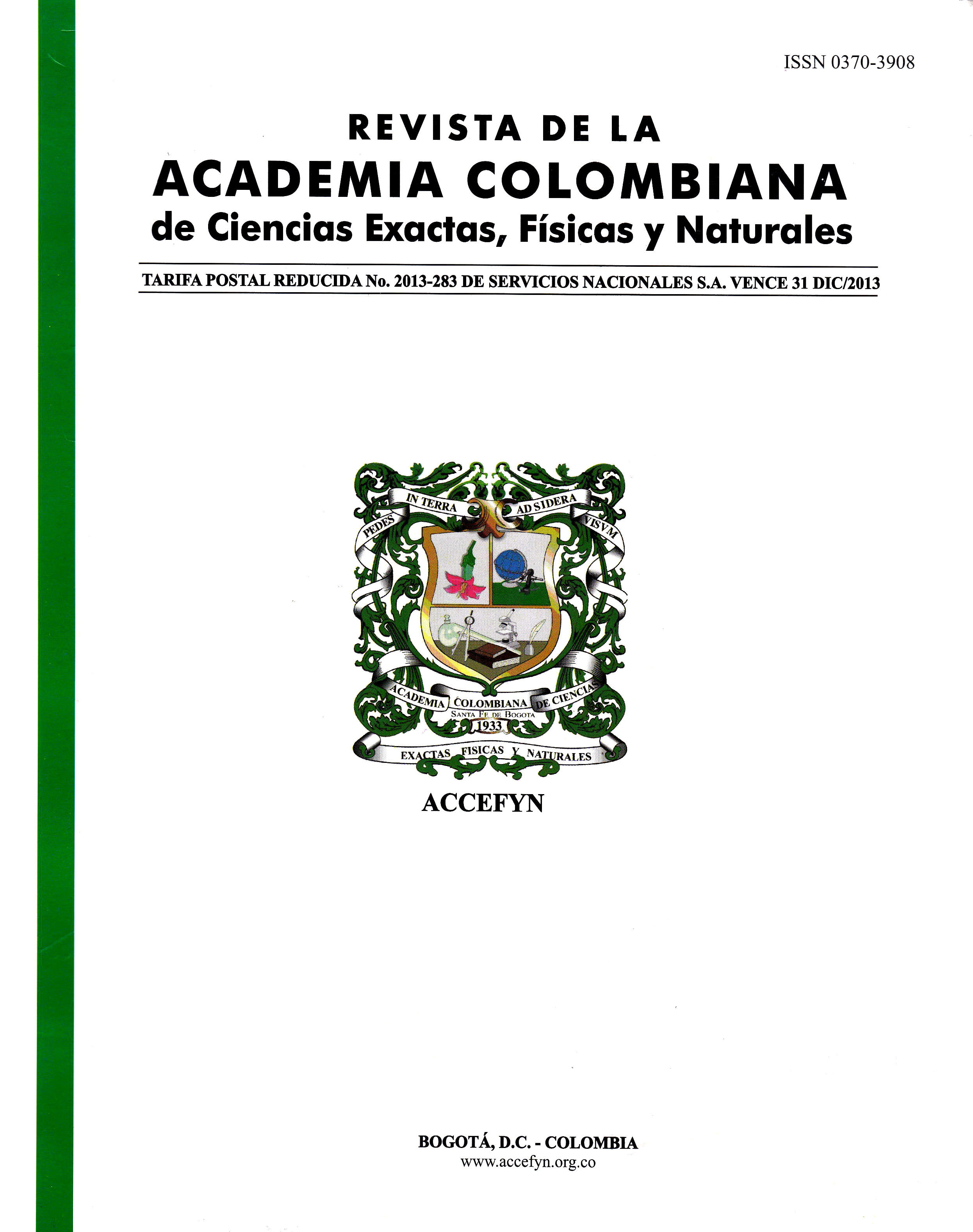Abstract
A disease in peach trees [Prunus persica (L.) Batsch] was dectected in the municipalities of Villamaría and Manizales (Caldas) with an incidence of 100%. The symptoms of the disease were flaccidity of the leaves, defoliation and drying of branches. Infected plants showed lesions resembling cankers with gum exudation. A Gram negative and fluorescent bacterium was isolated from diseased tissues in King´s B and nutrient agar media. The LOPAT tests showed: levano positive; oxidase, potato soft rot, arginine dihydrolase negative; and positive tobacco hypersensitivity reaction in tobacco plants. The pathogenicity of the bacterium was demonstrated by inoculating one year old peach trees, which showed similar symptoms to those observed in the field. Both biochemical and physiological tests indicated that the bacterium causing the dieback in peach at the department of Caldas belongs to Pseudomonas syringae pv. syringae
Keywords
References
Agrios, N. G. 2005. Plant pathology. 5th edition USA . Elsevier Academic Press. 922 p.
AGRONET. 2009. Análisis estadísticos. Web site: www.agronet.gov.co: 13 may. 2011.
Barzic, M. R. & Guittet, E. 1996. Structure and activity of persicomycins, toxins produced by a Pseudomonas syringae pv. persicae/Prunus persica isolate. European Journal of Biochemistry 239:702-709.
Byther, R. S. 1981. Bacterial canker of Prunus. Bulletin. Washington Nº 1013. pp. 1-2.
Campos, T. E. 1993. Historia de los frutales caducifolios en Colombia. En: Sarmiento, A. S. y Naranjo, C. O. Editores. Frutales Caducifolios. Bogotá. Presencia. 7p.
Del Río, L. & Sauceda, N. 1997. III. Bacterias fitopatógenas. En: Manual para el diagnóstico de hongos, bacterias, virus y nematodos fitopatógenos. Castaño-Zapata, J. y Del Río, L. Editores. Centro Editorial Universidad de Caldas-Zamorano Academic Press 210 p.
Goto, M. 1992. Fundamentals of bacterial plant pathology. San Diego. Academic Press 342 p.
Gross, D. C. & DeVay, J. E. 1977. Production and purification of syringomycin, a phytotoxin produced by Pseudomonas syringae. Physiological Plant Pathology 11:13-28.
Gubler, W.D. 1995. Cankers, blights, and wood rots. In: Ogawa, J. M.; Zehr, E. Y.; Ritchie, D. F. and Uyemoto, J. K. (editors). In: Compendium of Stone Fruit Diseases St. Paul, APS Press. Pp. 41.
Hattingh, M. J.; Roos, M. I. & Mansvelt E. L. 1989. Infection and systemic invasion of deciduous fruit trees by Pseudomonas syringae in South Africa. Plant Disease 73(10):784-789.
Hattingh, M. J. 1995. Diseases caused by bacteria: Bacterial canker. In: Compendium of Stone Fruit Diseases St Paul. APS Press. pp. 48-50.
Iacobellis. N. S.; Lavermicocca, P.; Grgurina, I.; Simmaco, M. & Ballio, A. 1992. A. Phytotoxic properties of Pseudomonas syringae pv. syringae toxins. Physiological and Molecular Plant Pathology 40:107-116.
Lelliot, R. A., Billing, E. & Hayward, A. C. 1966. A determinative scheme for the fluorescent plant pathogenic pseudomonads. Journal Applied Bacteriology 29:470-489.
Molina, G.D., & Parra, G. T. 2007. Producción de durazno en América Latina y Colombia. Semillero de Investigación de Economía. Internet: (www.geomundos.com/cultura/corpochitaga/ produccion-de-durazno-en-america-latina-y-colombia_ doc_17071.html). Acceso: 02 May. 2009.
Noval, C. 1991. Bacterias. Manual de laboratorio. Diagnóstico de hongos, bacterias y nemátodos fitopatógenos. Madrid : Ministerio de Agricultura, Pesca y Alimentación. Pp.113-275.
Pachón, G.O. & Bridg, H. 1993. Micropropagación in vitro del durazno blanco común (Prunus persica L.). Agricultura Tropical (Colombia) 30(1):101.
Shaad, N. W. 1988. Laboratory guide for identification of plant pathogenic bacteria. 2 ed. St. Paul. Minnesota : American Phytopathological Society pp.60-68.
Shaad, N. W. 1980. Laboratory guide for identification of plant pathogenic bacteria. Departament of Plant Pathology. University of Georgia. Pp. 60-77
Tello, J., Vares, F. & Lacasa, A. 1991. Manual de laboratorio. Diagnóstico de hongos, bacterias y nematodes fitopatógenos. Madrid. Ministerio de Agricultura, Pesca y Alimentación. Pp. 79-82.
Young, J. M. 1995. Bacterial decline. In: Ogawa, J. M.; Zehr, E. Y.; Ritchie, D. F. and Uyemoto, J. K. (editors). In: Compendium of Stone Fruit Diseases. St Paul APS. Pp. 50.

This work is licensed under a Creative Commons Attribution-NonCommercial-NoDerivatives 4.0 International License.
Copyright (c) 2023 https://creativecommons.org/licenses/by-nc-nd/4.0





